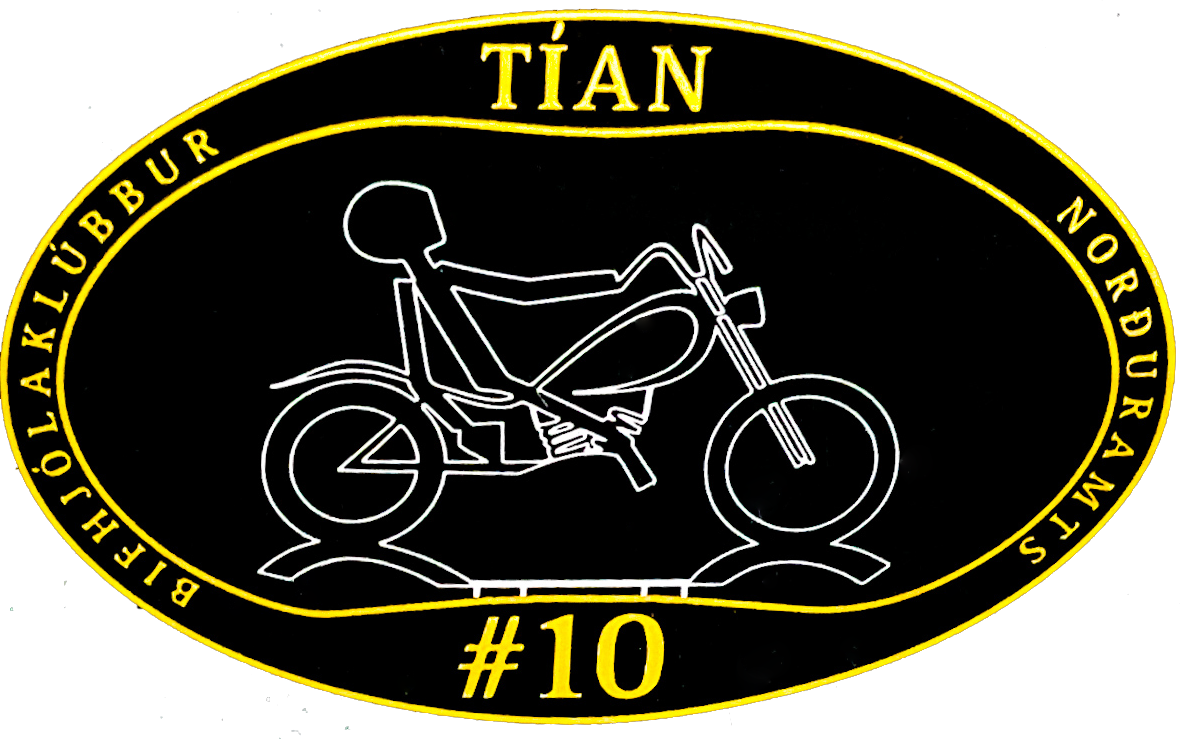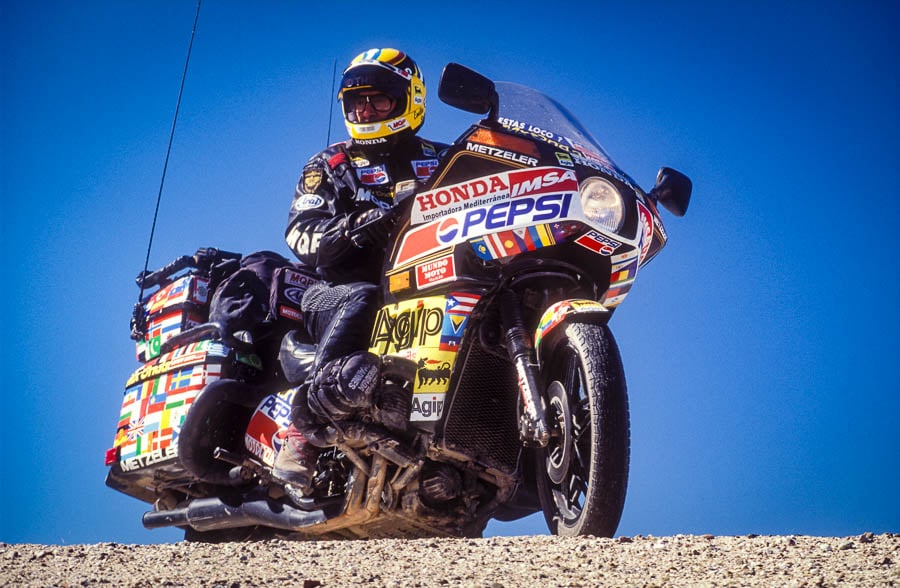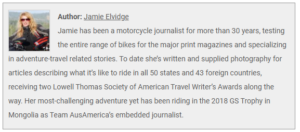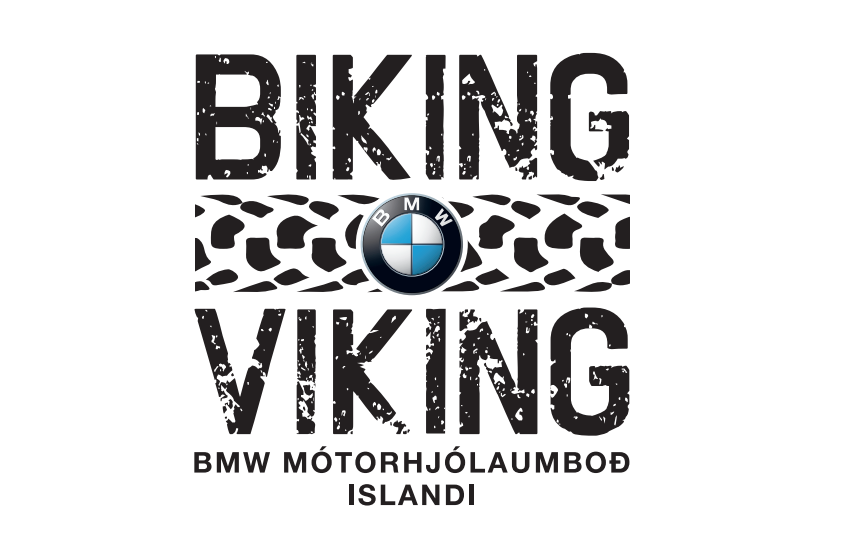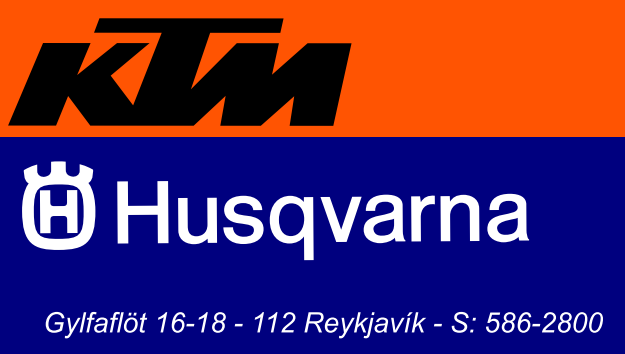
Emilio Scotto ásamt eiginkonu sinni, Monicu, fyrir aftan Svörtu prinsessuna, sem er Honda Goldwing 1100. Á milli sín halda þau á korti þar sem ferðalag Emilios er merkt inn á. Hann hefur verið á ferðinni síðan 14. janúar 1984 og hefur ekki komið til heimalands síns, Argentínu, síðan. Ferðinni lýkur hann í Buenos Aires eftir eitt ár og á þá að baki 750.000 km sem samsvarar ferð til tunglsins og aftur tiljarðar.
skipti sem hann hefur lent í fangelsi eða vegna veikinda. Ástæðan er sú að 14. janúar 1985
lagði hann af stað frá heimabæ sínum, Buenos Aires í Argentínu, í heimsreisu á mótorhjóli.
Takmarkið var að koma til allra þeirra ríkja í heiminum, þar sem stjórn eða landstjóri er
við lýði, hvort sem þau eru opin ferðamönnum eða lokuð.
„Ég varð meira að segja að fara til Tuvalo, sem er svo lítið að þar eru aðeins 24 bílar,“ sagði hann við blaðamann þegar hann leit inn á ritstjóm Morgunblaðsins í vikunni. Opnaði síðan stórt landakort af heiminum, þar sem ferðalag hans er merkt inn á og benti á örlítinn depil í Kyrrahafi langt frá fastalandinu. „Hérna er Ruvalo, eyja sem varð til í eldgosi,“ sagði hann. Tilgangurinn með ferðinni er einnig að aka 750.000 km eða svipaða fjarlægð og frá jörðinni til tunglsins og aftur til baka. Emilio hefur þegar farið einn hring í kringum hnöttinn og er nú á Ieiðinni til baka.
Að sögn hans eru ríkin alls 215 og er ísland 173. viðkomustaðurinn. Hann kom til landsins með Brúarfossi 5. apríl Og reiknaði með nokkurra daga dvöl hér áður en hann heldur áfram til Grænlands. „Ég veit ekki hvenær eða hvemig ég kemst þangað, því það er of dýrt að fijúga og ég veit ekki hvort nokkurt skip er á leiðinni þangað. Þannig er líf mitt, ég veit aldrei hvað bíður mín.“
Greinarskrif og ljósmyndir
Tímann hér notar hann til að safna efni í greinar, en hluta ferðarinnar fjármagnar hann með skrifum og Ijósmyndum í alls kyns spænsk, ítölsk og frönsk tímarit, sem hann er á samningi við. Ferðin er einnig farin í þeim tilgangi að kynnast menningu mismunandi þjóða. „Þetta er eins konar háskóli. Þegar ég var ungur og var spurður hvaða háskóla ég stefndi á og hvað ég ætlaði að verða sagðist ég vilja verða ævintýramaður og ferðast eins og Marco Polo og fleiri.
„Já, en það er ekki starfsgrein,“ var þá sagt við mig.
„Jú, ég ætla að gera það að starfi,“ sagði ég og hét því að gera ferðina að háskóla lífsins, þar sem mismunandi kynstofnar og kynslóðir kenndu mér allt mögulegt. Þetta hefur tekist á undanförnum níu árum. Ég er ekki Argentínumaður á ferðalagi, ég er íslendingur hér á landi, Kínverji í Kína o.s.frv. Þannig hef ég t.d. iært nokkur tungumál, en ég kunni bara spænsku þegar ég hóf ferðina.“
Emilio undirbjó sig vel, lærði m.a. landafræði og sögu auk þess sem hann kynnti sér alls kyns málefni á styttri námskeiðum, eins og hvernig ætti að komast af í frumskógum og eyðimörkum. „Þegar ég var þrítugur ákvað ég að láta slag standa, en það hafði enginn trú á ferðalaginu og því fékk ég engan til að styrkja mig. Ég lagði því af stað á Svörtu prinsessunni með einungis 300 dollara í vasanum, nokkur landabréf, en ekki einu sinni mótorhjólahjálm. Ég verð að viðurkenna, að fólkið á götunni var styrktaraðilar mínir fyrstu árin,“ segir hann svo og horfir brosandi á Monicu, eiginkonu sína, „og þá einkum konur“.
Emilio þykir greinilega tilhlýðilegt að útskýra þetta og segist hafa þekkt Moniciu í tvö ár áður en hann tók þá ákvörðun að leggja I heimsreisuna. „Hún sagði að ég skyldi fara í ferðina og lifa lífinu en hún biði eftir mér. Eg hélt af stað og svaf stundum á fimm stjörnu hótelum í boði hótelstjóranna eða á ströndinni undir berum himni. Stundum buðu konur mér að gista eða þær buðu mér í mat, í sumum tilvikum með samþykki eiginmannsins.“
Eftir sjö ára fjarveru bað Emilio Monicu og hún kom til Indlands þar sem hann var staddur. Þegar hann hélt, áfram ferðinni var hún með í för, en síðan sneri hún til Spánar, þar sem þau hyggjast hafa aðsetur í framtíðinni.
Opnar safn í Barcelona
Þegar ferðinni er lokið á næsta ári ætlar Emilio að opna safn í Barcelona, History of the Humans, þar sem allar heimildir um ferðina verða á einum stað, auk þess sem myndir og minjar um aðra þekkta ferðalanga verða einnig að því marki sem Emilio nær að safna heimildum. Hann hefur einnig samið bók um ferðalagið, sem verður gefin út á næsta ári, auk landabréfabókar með myndum. Bækurnar verða fyrst gefnar út á Spáni en síðar á fleiri tungumálum.
Emilio hefur nú þegar tekið 90.000 myndir og munu þær ásamt bókunum gagnast sem mikilvægar heimildir fyrir skóla, fyrirtæki, fjölmiðla og fleiri. „1 hveiju landi kaupi ég einnig sígilda tónlist hvers lands og þegar ég flyt fyrirlestra spila ég tónlist um leið, sem tengist landinu,“ segir hann.
Talinn njósnari Ghaddafis
Emilio segir að ferðin hafi að mestu gengið áfallalaust, hann hafi að vísu einu sinni lent i alvarlegu slysi á mótorhjólinu og lá í viku á spítala, í annað skipti fékk hann malaríu og lá veikur í tíu daga. Auk þess hefur hann setið í fangelsi, m.a. vegna þess að yfirvöld í Chad töldu hann vera njósnara á vegum Ghaddafis. Ástæðan var sú að hann hafði fengið sérstakt leyfi Ghaddafis til að komast inn í Líbýu, sem þá var lokað ferðamönnum. Hann losnaði úr fangelsinu með því að segja fangelsisyfirvöldum að hann hefði fengið góðar móttökur í Líbýu sem var talið „vonda“ landið en hins vegar fengi hann slæma meðferð í þessu „góða“ landi. Þeir sáu sér ekki annað vænna en sleppa honum „vegna þessa leiða misskilnings“, segir Emilio og ypptir öxlum brosandi.
Ég var líka settur í fangelsi í Zimbabve, vegna þess að þeir héldu að ég hefði falsað passann. Sömuleiðis í Afríku vegna myndatöku,“ heldur hann áfram. „Eitt sinn var ég þó í lífshættu. Það var í Sómalíu, en ég var þar þegar stríðið hófst og lenti í miðri skothríð milli hermannanna og fólksins. — Hvað um það, þetta er það líf sem ég lifi. Fólk hefur oft spurt mig hvað gerist þegar ég hef lokið ferðalaginu. Hjá mér er aldrei mánudagur eða þriðjudagur eða klukkustundir eða mínútur. Ég lifi bara við það að sólin kemur upp á morgnana og tunglið birtist á næturnar,“ segir hann. „Ég get aldrei búið við það að eitthvað ákveðið eigi að gerast kl. 8 á mánudagsmorgni eða 9 á þriðjudegi.“
Er nú betri efnum búinn
Á sama hátt og Emilio gekk erfiðlega að fá menn til að leggja fé til ferðarinnar í upphafi hafa streymt til hans styrktaraðilar nú. Má þar nefna Pepsi Cola, sem er stærsti styrktaraðili hans, Honda, ýmsar sjónvarpsstöðvar og fleiri aðilar. „Vegna þessara fyrirtækja get ég frekar einbeitt mér að vinnu í stað þess að vera sífellt að leita fjármögnunarleiða. Nú hef ég efni á að eiga góða myndavél og get þannig gefið fólki kost á að sjá það sem ég sé á ferðalögum mínum.“
Vegna þess að flökkueðlið er orðið Emilio svo eðlilegt segist hann ætla að stofna fyrirtæki og bjóða fólki upp á að kynnast löndum á annan og meira spennandi hátt en tíðkast hafi hingað til. Auk þess muni hann flytja fyrirlestra og gefa út bækur. „Mig langar líka til að búa til kvikmynd um ferðina. Þar sem ég hef ágæt sambönd í Bandaríkjunum ætla ég að reyna að fá Steven Spielberg eða annan þekktan leikstjóra til að taka verkið að sér.“ Hann sér þó ekki sjálfan sig í hlutverkinu heldur góðan leikara, enda er kannski óþarfi að fara í þriðju heimsreisuna strax aftur?
MBL 10.4.1994
eftir Hildi Friðriksdóttur
Uppfærsla frá 20.10.2024
Emilio Scotto: The World’s Longest Journey On A Motorcycle
A legendary RTW adventure aboard a 900-pound Honda Gold Wing.
Without a doubt, the claim to the longest motorcycle adventure of all time belongs to Argentinian rider Emilio Scotto, who from 1985 to 1995 rode 456,729 miles, visiting 279 countries, islands, colonies and non-independent countries without returning home, circumnavigating the world not once, but twice.
The adventures he encountered along the way read like a Hollywood blockbuster, and all were captured in his book “The Longest Ride.” Highlights include how the young rider, having left Argentina with just $306, survived five robberies, the first, in Brazil, leaving him with nothing but his passport just weeks into his journey. He was jailed six times, shot at twice and came out the other side of a major earthquake, two tornadoes, four hurricanes and a massive sandstorm that threw him from his bike in the Sahara desert.

The crown jewel of his expedition is a Guinness World Record for “Longest Journey on a Motorcycle,” an honor he still holds 30 years later. And while Scotto enjoys this honor, he says it does little to illustrate the true magnificence of his travels, or the challenges that no longer exist in a connected world.
Scotto was 30 years old when he quit his job and left Buenos Aires aboard a 1980 GL1100 Gold Wing Interstate that would come to be known as the Black Princess. Though he’d long dreamed of traveling the world, he set off with hardly a goodbye from his friends and family. “They thought I would return home the next day!” he laughs now, looking back at just how crazy his endeavor must have sounded at the time.

To say he left unprepared is putting it lightly, and he admits now he hadn’t even considered border crossings, regulations, political unrest or even language barriers. “I didn’t really have any idea what it meant to go around the world.” In fact, the only maps he’d really seen at the time had been in an Atlas he received as a child from his mother. “There weren’t paper maps in Argentina, even maps of Argentina,” he says of that era.

When he first rode off he admits he was as overpacked as he was underprepared, describing how, as he approached his first border crossing, from Argentina into Uruguay, the guards broke out into laughter at the sight of his overloaded touring bike. Asked today if he’d still head out in the world knowing all the peril that awaited him, Scotto thinks about this for a minute and says a firm, “Yes. It was my destiny.”
Crossing the Amazon, By Accident
As an example of his naivety, Scotto ascended the east coast of South America, not understanding there were no roads, or even paths, through the Amazon, the world’s most impenetrable jungle. When he learned of his error he refused to backtrack for thousands of miles to the Pan American Highway on the west coast of South America, instead rustling up a boat captain willing to take him and his bike up the Amazon River to Manaus, Brazil.
It’s on this battered ship that one of the first of Scotto’s legendary stories takes place. Aside from himself, the boat was carrying a couple dozen nefarious characters. “As I watched and listened to them, it became clear that these people were outlaws, people living on the fringe of society.”

One night toward the end of the week’s long journey there was a card game. The leader of the criminals at first told him not to play, but later, forcefully invited him to take an empty seat. “On the table was money and gold as currency, plus weapons — guns and knives,” he remembers.
Although he was not trying to win, he was shocked when he won several hands in a row. Soon the players started saying he must be cheating and a gun was drawn. When Scotto tried to return the money they were even more incensed, saying he’d insulted them. He remembers one saying he might not make it to shore. Needless to say it was a long night for the traveler.
When he was disembarking the next morning, the guys from the card game walked by, seeming to grin and wink his way, and when the leader passed, he handed Scotto a crumbled note that wished him well on the rest of his journey. “Do you understand now?” the man said. They had wanted to help fund Scotto’s journey, “By helping you we go with you.”
It was in similar ways that the universe continued to provide passage for Scotto. He says he always had a place to sleep and meals to eat, thanks not only to the kindness of people, but their curiosity. They were hungry for stories of his adventures at a time when it wasn’t easy to learn about the world. Scotto also took short jobs along the way, an opening always there when he needed one.
Americas The Beautiful
In Nicaragua Scotto was shot at the first time by soldiers who mistook him for a CIA agent spying for the Contras, the group of rebels at the time trying to overthrow the country’s socialist government with the help of US funding. He had to work hard to convince them he was actually a tourist. In another country he was accused of being a hired assassin and imprisoned until he could sort it out.
His favorite Honduras story is quite different. In the middle of nowhere he’d gotten a flat and removed the wheel. It was getting dark when some villagers offered to take the wheel and have it repaired. They returned after midnight, the tire fixed, and directed him to a place where he could spend the night. When Emilio tried to pay them, he was told. “It was a favor, you don’t pay for favors.”

When Scotto reached the United States he was enchanted by the order and cleanliness. He loved America and went on to see all the sights, though he felt pulled most strongly by Hollywood, and Hollywood loved him right back, he says, remembering how Tom Cruise reserved the rights to his story, renewing them several times at a price of $25,000 each three months. During this back-and-forth Scotto learned a manager he’d hired had secretly stolen the rights to his story.
Eventually he would win back the rights in court, but in the meantime, Scotto was headed to Europe and beyond, where his adventures would reach new heights.
Europe, Behind the Iron Curtain and Into Africa
Scotto enjoyed his time in Western Europe, but found an extreme contrast to how people were living behind the Iron Curtain, in what was then the Union of Soviet Social Republics (USSR). Just the fact he was allowed into that part of the world, actually crossing through “Checkpoint Charlie,” the most infamous crossing point along the Berlin Wall, was a feat of determination.

It was his Embassy in Poland, he says, which finally gave him a clandestine visa after he’d shown up for weeks, pleading for entry. “Poland hated being in the Soviet Union, of course,” he remarks, explaining how the officials seemed to get a kick out of it when they finally allowed him entry. And what Scotto found behind The Curtain was depressing, especially in the poorest, most oppressed countries, such as Romania, where he found people were too afraid to even speak with him.
For the next adventure, Scotto was riding in Africa where he explored all of the continent’s 55 countries. It was this part of the journey he remembers as the most difficult. “It was a year without tarmac, of crossing rivers without bridges,” he says. And indeed, crossing the Sahara desert on a luxury touring motorcycle that weighed 800 pounds fully loaded sounds impossible, and at times it nearly was. For example, Scotto has often told the tale of a four hour-long sandstorm so brutal he was blown from his bike and forced to curl up in a ball, barely able to breathe.

On the West Coast of Africa Scotto described in his book potholes 10 feet long and 4 feet wide that were filled with “supremely smelly, primeval soup, covered with a dry, brownish green scum.” In Africa’s jungles, which he described as casting every imaginable shade of green, he remembers being incessantly hot and covered in mosquito bites as he endured humidity that “irritated, exhausted and crushed.”
In his book, Scotto sums up his time in Africa with these words: “I had encountered a million unexpected things — new lands, deadly situations, new rules, new beliefs, new realities, children starving, armies fighting, and human sacrifices.” So primitive were some areas, he wrote about a time he was nearly poisoned and consumed by a tribe of cannibals who offered him a mysterious liquid to drink. Lucky for Scotto, a friend in Senegal had warned him about the cannibals, so he beat a hasty retreat, recalling how hands were clutching his shirt as he ran for his bike.

“I emerged from Africa a bit scared but definitely battle-hardened,” he wrote.
Onward To Asia And A Second Circumnavigation
Scotto also had many interesting experiences in Asia, the largest of the world’s continents, including in India, a country he remembers as one of the most warm and inviting, when he was joined by the girlfriend he’d left behind in Argentina, Monica Pinos, who flew to meet and marry Scotto in India, where they would ride two-up for several months, enjoying a one-of-a-kind, makeshift honeymoon.
Once solo again, Scotto rode through Southeast Asia, Australia and many islands of the South Pacific, at least one of which had never before had a motorcycle touch its soil.

Having made his way around the world in one direction, Scotto had no plan to hang up his helmet, instead heading in the opposite direction so that he could visit any countries he had missed. Back in Asia he and the Black Princess visited Honda Japan where he was welcomed as a hero, while his Gold Wing massaged back to freshness by Honda’s factory mechanics, one of which had deemed its state “unrideable.”
Wanting to explore the then-mysterious China he was told at its border he would need to pay $70,000 for an entry visa. Never one to turn away from a challenge, Scotto found an audience in the Beijing 2000 Olympics committee, who enlisted him to help promote the “goodwill” of the Olympics by allowing him not only entry into China, but the ability to travel “with no restrictions, no supervision, an arrangement simply unheard of,” he wrote. “More importantly, I could change money freely, just as if I were a Chinese citizen instead of a tourist—a privilege that gave me great leverage with the little money I had.”

His time in China included riding alongside the Great Wall for 1,000 miles, and Scotto even managed to travel into Mongolia, where he claims he was the first outsider to tour the country in 75 years. And yes, that included navigating the Gobi desert on his Gold Wing.

When he finally arrived at the border of the Soviet Union, he was surprised to learn that the Iron Curtain had fallen, which caused an interesting glitch. Despite its newfound independence, the country of Kazakhstan was still refusing entry to foreigners, and the country he was departing, China, could not guarantee his return back across the border, leaving Scotto to live for two days as an exile in a half mile-wide strip of land between the countries with no food or water.

With the help of a TV crew that arrived to interview him about his predicament, Scotto was allowed back into China and had to backtrack 4,000 miles to Beijing in order to secure a Kazakhstan visa from the Russian embassy. Once he finally regained entry into what had been the Soviet Union, he found it was in some ways even darker than before, “now ruled by thugs and gangsters.”
The Long Road Home
When Emilio Scotto did finally wrap up the longest-ever journey on a motorcycle in 1995, he’d been on the road for 10 years, two months and 19 days and 11 passports.
The Gold Wing had consumed one replacement engine, 86 tires, 12 batteries and nine seats, not to mention an estimated 12,500 gallons of gas and 300 gallons of oil.

Asked if he’d choose another motorcycle, knowing everything he knows now, he says he’d still pick a Gold Wing. Unsurprisingly the Honda was incredibly reliable. “I know Honda didn’t build this bike to go across Africa,” he says, “but it did.” To this day he still boasts of the Interstate’s luxury and the joy of listening to music along the way. He was always comfortable and entertained and that made it easier to continue.

Some of you will remember reading “The Longest Ride,” which described hundreds of his incredible stories. The good news is he’s currently writing a new series of Spanish language books that explore his journey to the fullest, with the first editions already winning prestigious awards, including a Bronze award for best travel book at the 26th annual International Latino Book Awards, held on October 19, 2024 in Los Angeles, California.

Scotto and his wife Monica also own a travel company, Emilio Scotto World Tours, which allows him to share his favorite parts of the planet with other riders.
As for the Gold Wing, the Black Princess is living out its retirement on display at Don Laughlin’s Classic Car Museum in Laughlin, Nevada.
Photos courtesy Emilio Scotto.
